Brahea: Difference between revisions
No edit summary |
No edit summary |
||
| (4 intermediate revisions by 2 users not shown) | |||
| Line 1: | Line 1: | ||
{{ | {{SPlantbox | ||
| | |familia=Arecaceae | ||
| | |genus=Brahea | ||
| | |habit=palm-cycad | ||
|origin=Mexico, C America | |||
|lifespan=perennial | |||
| origin = Mexico, C America | |exposure=sun | ||
|features=drought tolerant | |||
| lifespan = | |Temp Metric=°F | ||
| exposure = | |jumpin=If this plant info box on watering; zones; height; etc. is mostly empty you can click on the edit tab and fill in the blanks! | ||
| | |image=Brahea armata form.jpg | ||
| | |image_width=240 | ||
|image_caption=Brahea armata (young plant) | |||
| | }} | ||
'''''Brahea''''' is a [[genus]] of palms in the [[Arecaceae]] [[family (biology)|family]]. They are commonly referred to as '''Hesper Palms''' and are endemic to [[Mexico]] and [[Central America]]. All Hesper Palms have large, fan-shaped leaves. | |||
{{Inc| | |||
|image = Brahea armata form.jpg | Brahea (Tycho Brahe, the Danish astronomer). Palmaceae, tribe Corypheae. Medium-sized, usually spineless palms except on the leaf-stalks, with ringed trunks, the upper part of which is usually clothed with the persistent leaf-bases. | ||
|image_caption = ''Brahea | |||
Leaves usually numerous, nearly round and somewhat peltate, the many lfts. plicate and deeply 2- parted, sometimes slightly spiny on the margin, more often filamentous; petioles flattened, dentate or rarely spiny along the margins, very fibrous at the sheathing base: spathes usually linear, firm, almost woody, frequently perfectly glabrous; spadix much branched, sometimes twice or thrice paniculate and bearing among the dense white wool 1 or many sessile fls. in each cluster; fls. hermaphrodite, sometimes with inconspicuous bracts, 3 nearly round sepals, 3 valvate petals and 6 stamens: fr. small, ovoid, sometimes pubescent. Beccari admits only 4 species, all Mexican except B. salvadorensis. From its nearest horticultural relative, Sabal, Brahea is distinguished by the purely technical character of having 3 free carpels. | |||
| | |||
In a moderately warm house, the cultivated braheas will thrive very well. A mixture of sand, rich loam and well-rotted horse- or cow-manure is best. They require plenty of water. They are not very common in the trade but two species are grown outdoors in southern California. Propagation is by seeds, which are rare. | |||
B. edulis, Wendl., sometimes offered in Amer., is Erythea edulis, Wats. — B. filamentosa, Hort. Washingtonia filifera. Wendl. — B. filifera, Hort.-W. fiiifera. — B. glauca, Hort. - Erythea armata, Wats. — B. robusta, Hort.-Washingtonia. — B, Roezlii, Erythea armata, Wats. | |||
}} | }} | ||
==Cultivation== | |||
===Propagation=== | |||
===Pests and diseases=== | |||
==Species== | |||
There are 11 [[species]] described in the genus as follows: | |||
*''[[Brahea aculeata]]'' <small>(Brandegee) H.E.Moore</small> (Sinaloa Hesper Palm) | |||
*''[[Brahea armata]]'' <small>S.Watson</small> (Blue Hesper Palm, Mexican Blue Palm) | |||
*''[[Brahea brandegeei]]'' <small> (Purpus) H.E.Moore</small> (San Hose Hesper Palm, Palma de Taco) | |||
*''[[Brahea calcarea]]'' <small>Liebm</small> | |||
*''[[Brahea decumbens]]'' <small>Rzed. </small> | |||
*''[[Brahea dulcis]]'' <small> (Kunth) Mart. </small> (Rock Palm) | |||
*''[[Brahea edulis]]'' <small>H.Wendl. </small> (Guadalupe Palm) | |||
*''[[Brahea moorei]]'' <small>L.H.Bailey ex H.E.Moore</small> | |||
*''[[Brahea pimo]]'' <small>[[Odoardo Beccari|Becc.]] </small> | |||
*''[[Brahea salvadorensis]]'' <small>H.Wendl. ex [[Odoardo Beccari|Becc.]] </small> | |||
*''[[Brahea sarukhanii]]'' <small>H.J.Quero</small> | |||
Move following info onto individual pages: | |||
{{Speciesbox | {{Speciesbox | ||
| latin_name = Brahea aculeata | | latin_name = Brahea aculeata | ||
| Line 174: | Line 193: | ||
| description = | | description = | ||
}} | }} | ||
==Gallery== | |||
<gallery perrow=5> | |||
Image:Upload.png| photo 1 | |||
Image:Upload.png| photo 2 | |||
Image:Upload.png| photo 3 | |||
</gallery> | |||
==References== | |||
<references/> | |||
*[[Standard Cyclopedia of Horticulture]], by L. H. Bailey, MacMillan Co., 1963 | |||
<!--- xxxxx *Flora: The Gardener's Bible, by Sean Hogan. Global Book Publishing, 2003. ISBN 0881925381 --> | |||
<!--- xxxxx *American Horticultural Society: A-Z Encyclopedia of Garden Plants, by Christopher Brickell, Judith D. Zuk. 1996. ISBN 0789419432 --> | |||
<!--- xxxxx *Sunset National Garden Book. Sunset Books, Inc., 1997. ISBN 0376038608 --> | |||
==External links== | ==External links== | ||
* | *{{wplink}} | ||
{{stub}} | |||
__NOTOC__ | |||
Latest revision as of 21:37, 10 February 2010
| Brahea subsp. var. | ||||||||||||||||||||||||||||||||||||||||||||||||||||||||
|---|---|---|---|---|---|---|---|---|---|---|---|---|---|---|---|---|---|---|---|---|---|---|---|---|---|---|---|---|---|---|---|---|---|---|---|---|---|---|---|---|---|---|---|---|---|---|---|---|---|---|---|---|---|---|---|---|

|
|
| ||||||||||||||||||||||||||||||||||||||||||||||||||||||
| ||||||||||||||||||||||||||||||||||||||||||||||||||||||||
Brahea is a genus of palms in the Arecaceae family. They are commonly referred to as Hesper Palms and are endemic to Mexico and Central America. All Hesper Palms have large, fan-shaped leaves.
| Standard Cyclopedia of Horticulture |
|---|
|
Brahea (Tycho Brahe, the Danish astronomer). Palmaceae, tribe Corypheae. Medium-sized, usually spineless palms except on the leaf-stalks, with ringed trunks, the upper part of which is usually clothed with the persistent leaf-bases. Leaves usually numerous, nearly round and somewhat peltate, the many lfts. plicate and deeply 2- parted, sometimes slightly spiny on the margin, more often filamentous; petioles flattened, dentate or rarely spiny along the margins, very fibrous at the sheathing base: spathes usually linear, firm, almost woody, frequently perfectly glabrous; spadix much branched, sometimes twice or thrice paniculate and bearing among the dense white wool 1 or many sessile fls. in each cluster; fls. hermaphrodite, sometimes with inconspicuous bracts, 3 nearly round sepals, 3 valvate petals and 6 stamens: fr. small, ovoid, sometimes pubescent. Beccari admits only 4 species, all Mexican except B. salvadorensis. From its nearest horticultural relative, Sabal, Brahea is distinguished by the purely technical character of having 3 free carpels. In a moderately warm house, the cultivated braheas will thrive very well. A mixture of sand, rich loam and well-rotted horse- or cow-manure is best. They require plenty of water. They are not very common in the trade but two species are grown outdoors in southern California. Propagation is by seeds, which are rare. B. edulis, Wendl., sometimes offered in Amer., is Erythea edulis, Wats. — B. filamentosa, Hort. Washingtonia filifera. Wendl. — B. filifera, Hort.-W. fiiifera. — B. glauca, Hort. - Erythea armata, Wats. — B. robusta, Hort.-Washingtonia. — B, Roezlii, Erythea armata, Wats.
|
Cultivation
Propagation
Pests and diseases
Species
There are 11 species described in the genus as follows:
- Brahea aculeata (Brandegee) H.E.Moore (Sinaloa Hesper Palm)
- Brahea armata S.Watson (Blue Hesper Palm, Mexican Blue Palm)
- Brahea brandegeei (Purpus) H.E.Moore (San Hose Hesper Palm, Palma de Taco)
- Brahea calcarea Liebm
- Brahea decumbens Rzed.
- Brahea dulcis (Kunth) Mart. (Rock Palm)
- Brahea edulis H.Wendl. (Guadalupe Palm)
- Brahea moorei L.H.Bailey ex H.E.Moore
- Brahea pimo Becc.
- Brahea salvadorensis H.Wendl. ex Becc.
- Brahea sarukhanii H.J.Quero
Move following info onto individual pages:
|
File:Upload Filename | |||||||||||||||
|
File:Upload Filename | |||||||||||||||
|
File:Upload Filename | |||||||||||||||
|
File:Upload Filename | |||||||||||||||
|
File:Upload Filename | |||||||||||||||
|
File:Upload Filename | |||||||||||||||
|
File:Upload Filename | |||||||||||||||
|
File:Upload Filename | |||||||||||||||
|
File:Upload Filename | |||||||||||||||
|
File:Upload Filename | |||||||||||||||
Gallery
-
photo 1
-
photo 2
-
photo 3
References
- Standard Cyclopedia of Horticulture, by L. H. Bailey, MacMillan Co., 1963
External links
- w:Brahea. Some of the material on this page may be from Wikipedia, under the Creative Commons license.
- Brahea QR Code (Size 50, 100, 200, 500)

